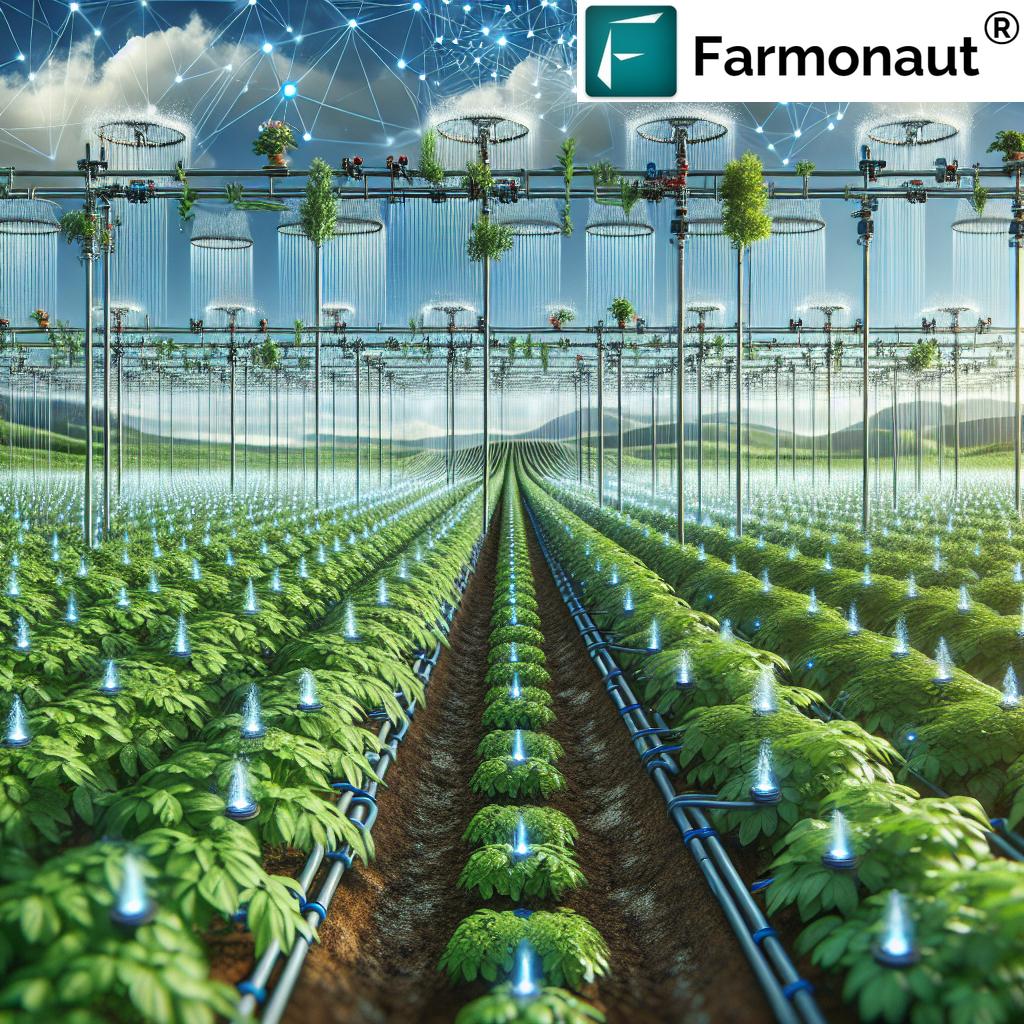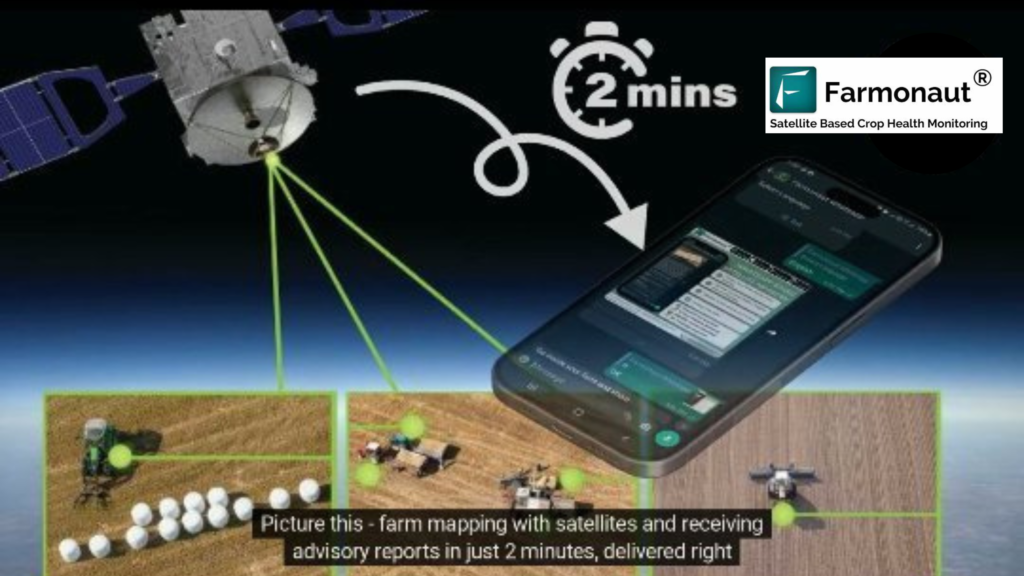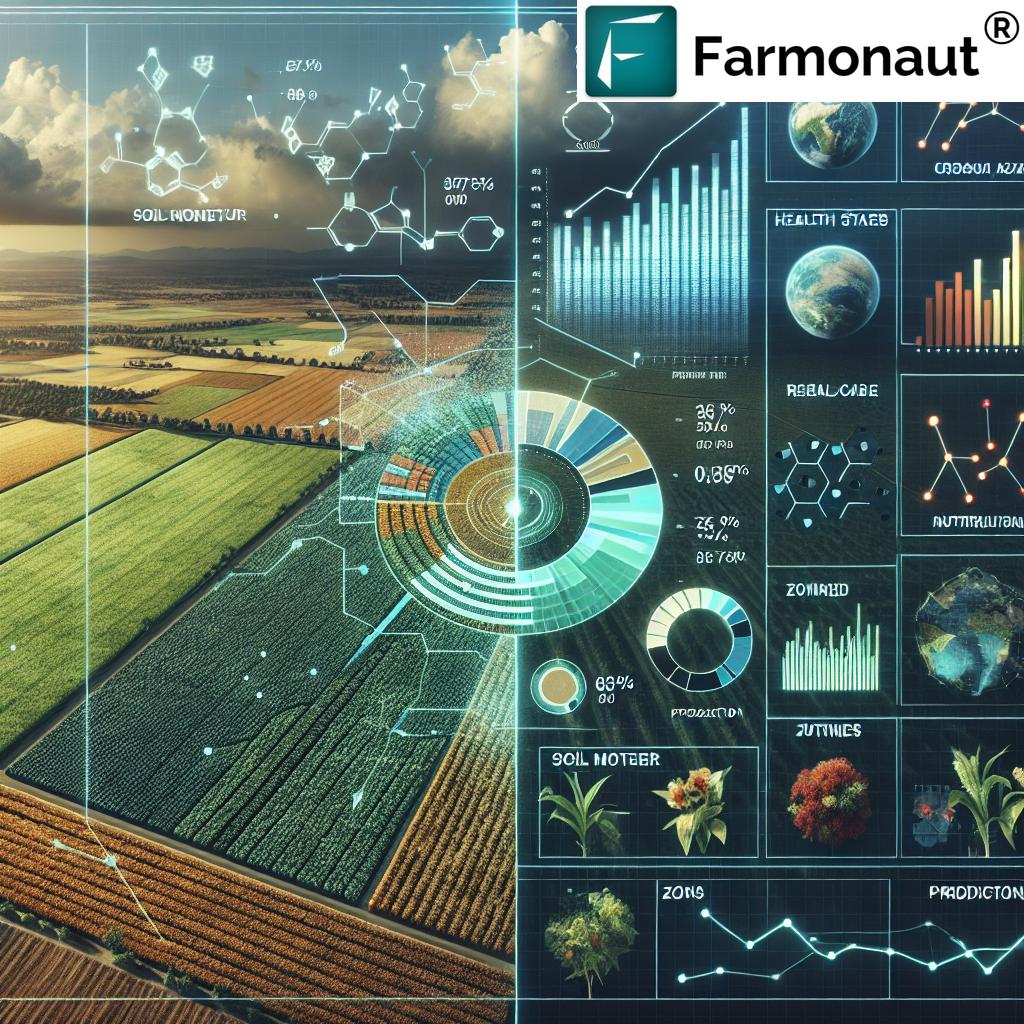Unlocking Soil Health: Understanding Carbon Percentage and Organic Matter in Agriculture
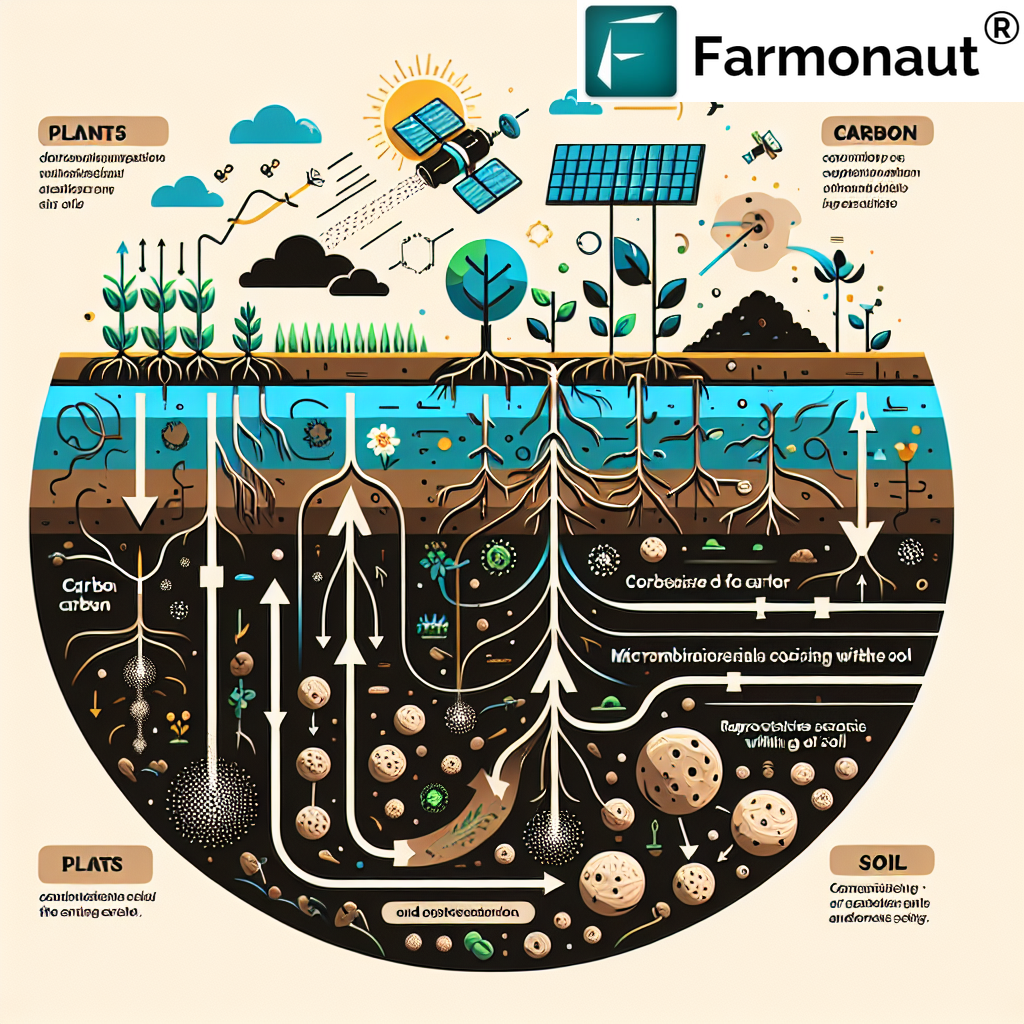
In the ever-evolving world of agriculture, understanding the intricacies of soil health is paramount to achieving sustainable and productive farming practices. At Farmonaut, we’re committed to empowering farmers with cutting-edge technology and knowledge to optimize their agricultural endeavors. Today, we’re delving deep into a crucial aspect of soil health: carbon percentage and organic matter. This comprehensive guide will explore the significance of carbon in soil, methods to measure it, and how it impacts overall soil fertility and crop productivity.
The Importance of Soil Carbon
Soil carbon plays a vital role in maintaining soil health and supporting plant growth. It’s a key component of soil organic matter, which is essential for:
- Improving soil structure and water retention
- Enhancing nutrient availability and cycling
- Supporting beneficial soil microorganisms
- Increasing soil resilience to erosion and compaction
- Sequestering atmospheric carbon, thus mitigating climate change
Understanding the
carbon percentage in soil is crucial for farmers and agronomists to assess soil health and make informed decisions about land management practices.
Measuring Carbon Percentage in Soil
Determining the
percentage of carbon in soil is a fundamental step in assessing soil health. There are several methods to measure soil carbon content, each with its own advantages and limitations:
1. Loss on Ignition (LOI) Method
This method involves heating a soil sample to high temperatures (typically 350-440°C) to burn off organic matter. The weight loss after burning is used to estimate the organic carbon content. While relatively simple and inexpensive, this method can overestimate carbon content in soils with high clay content or carbonates.
2. Wet Oxidation Method (Walkley-Black Method)
This widely used method involves oxidizing organic carbon with potassium dichromate and sulfuric acid. The amount of dichromate reduced is proportional to the organic carbon content. It’s relatively accurate but can underestimate total organic carbon in some soils.
3. Dry Combustion Method
Considered the most accurate method, dry combustion uses specialized equipment to heat soil samples to very high temperatures (900-1000°C) in the presence of oxygen. The CO2 released is measured to determine total carbon content. This method can distinguish between organic and inorganic carbon but requires expensive equipment.
4. Near-Infrared Spectroscopy (NIRS)
This non-destructive method uses the absorption of near-infrared light to estimate soil carbon content. While it requires initial calibration with traditional methods, NIRS can provide rapid and cost-effective analysis of large numbers of samples.
Understanding the Percentage of Organic Carbon in Soil Formula
The
percentage of organic carbon in soil formula is a crucial calculation for assessing soil health. The basic formula is:
% Organic Carbon = (Weight of Organic Carbon / Weight of Soil Sample) x 100
However, the specific method used to determine the weight of organic carbon can vary. For instance, when using the Walkley-Black method, the formula is more complex:
% Organic Carbon = [0.003 x (V1 – V2) x M x 100 x f] / S
Where:
- V1 = Volume of ferrous ammonium sulfate solution used for blank (mL)
- V2 = Volume of ferrous ammonium sulfate solution used for sample (mL)
- M = Concentration of ferrous ammonium sulfate solution (mol/L)
- S = Weight of air-dried soil (g)
- f = Correction factor (usually 1.33)
At Farmonaut, we understand that these calculations can be complex. That’s why our
satellite-based farm management platform integrates advanced algorithms to provide accurate soil health assessments, including organic carbon content, without the need for complex manual calculations.
Interpreting Soil Carbon Percentages
Understanding what the carbon percentage means for your soil is crucial. Here’s a general guide to interpreting soil organic carbon levels:
- Very Low: Less than 0.5%
- Low: 0.5-1.5%
- Medium: 1.5-2.5%
- High: 2.5-3.5%
- Very High: More than 3.5%
However, it’s important to note that ideal carbon levels can vary depending on soil type, climate, and land use. Our
Farmonaut API provides contextualized interpretations based on local conditions and historical data.
Factors Affecting Soil Carbon Levels
Several factors influence the carbon percentage in soil:
- Climate: Temperature and precipitation affect the rate of organic matter decomposition.
- Soil Texture: Clay soils tend to retain more organic carbon than sandy soils.
- Land Use: Agricultural practices, such as tillage and crop rotation, significantly impact soil carbon levels.
- Vegetation: The type and amount of plant residues returned to the soil affect carbon inputs.
- Topography: Slope and aspect influence erosion rates and organic matter accumulation.
- Microbial Activity: Soil microorganisms play a crucial role in carbon cycling and stabilization.
Strategies to Increase Soil Carbon
Improving soil carbon levels is essential for sustainable agriculture. Here are some effective strategies:
- Reduced Tillage: Minimize soil disturbance to slow organic matter decomposition.
- Cover Crops: Plant cover crops to increase organic matter inputs and protect soil from erosion.
- Crop Rotation: Implement diverse crop rotations to improve soil structure and organic matter content.
- Organic Amendments: Apply compost, manure, or other organic materials to boost soil carbon.
- Agroforestry: Integrate trees into agricultural landscapes to increase carbon sequestration.
- Precision Agriculture: Use technologies like Farmonaut’s satellite-based monitoring to optimize resource use and minimize soil degradation.
The Role of Technology in Soil Carbon Management
At Farmonaut, we’re at the forefront of integrating technology into soil health management. Our satellite-based monitoring system provides farmers with valuable insights into their soil’s carbon content and overall health. Here’s how our technology compares to traditional monitoring methods:
| Feature |
Farmonaut Satellite System |
Drone-based Monitoring |
IoT-based Monitoring |
| Coverage Area |
Large scale (regional to global) |
Limited (local) |
Limited (point-based) |
| Frequency of Data Collection |
Regular (every few days) |
As needed (manual flights) |
Continuous |
| Cost-effectiveness |
High |
Medium |
Low (high initial investment) |
| Ease of Use |
Very High (no on-site equipment needed) |
Medium (requires pilot) |
Medium (requires maintenance) |
| Data Processing |
Automated with AI |
Semi-automated |
Automated |
| Integration with Other Data |
Seamless (weather, historical data, etc.) |
Limited |
Moderate |
Our satellite-based system offers unparalleled coverage and cost-effectiveness, making it an ideal solution for farmers of all scales. Download our app for
Android or
iOS to experience the power of satellite-based farm management firsthand.
Case Studies: Successful Soil Carbon Management
While we don’t have specific case studies to share, our experience working with farmers worldwide has shown that implementing the abovementioned strategies, combined with our satellite monitoring technology, can significantly improve soil carbon levels and overall farm productivity.
The Future of Soil Carbon Management
As we look to the future, the importance of soil carbon management in agriculture will only grow. Emerging technologies and practices are set to revolutionize how we approach soil health:
- Carbon Markets: Developing carbon credit systems for agriculture could incentivize farmers to adopt carbon-sequestering practices.
- Biochar: This stable form of carbon has shown promise in long-term carbon sequestration and soil improvement.
- Gene Editing: Developing crops with enhanced root systems could increase carbon inputs to soil.
- AI and Machine Learning: Advanced algorithms will provide even more accurate predictions and recommendations for soil management.
At Farmonaut, we’re constantly innovating to stay ahead of these trends. Our
satellite and weather API is designed to integrate seamlessly with emerging technologies, ensuring that our users always have access to the most advanced soil management tools available.
Conclusion
Understanding and managing the carbon percentage in soil is crucial for sustainable agriculture and environmental stewardship. By leveraging advanced technologies like Farmonaut’s satellite-based monitoring system, farmers can gain valuable insights into their soil health and make informed decisions to improve carbon sequestration and overall productivity.
We invite you to join us in this journey towards more sustainable and productive agriculture. Subscribe to Farmonaut today and unlock the power of precision farming:
FAQs
Q: How often should I measure the carbon percentage in my soil?
A: We recommend annual measurements to track changes over time. However, with Farmonaut’s satellite monitoring, you can get regular soil health indicators updates without requiring frequent manual testing.
Q: Can increasing soil carbon improve crop yields?
A: Yes, higher soil carbon levels generally lead to improved soil structure, water retention, and nutrient availability, which can contribute to better crop yields.
Q: How long does it take to see improvements in soil carbon levels?
A: Significant changes in soil carbon can take several years to manifest. However, with consistent management practices and the insights provided by Farmonaut’s technology, you can track progress and make adjustments in real-time.
Q: Is soil carbon the same as soil organic matter?
A: Not exactly. Soil organic matter contains carbon, but it also includes other elements like nitrogen, phosphorus, and sulfur. Generally, soil organic matter is about 58% carbon.
Q: How does climate change affect soil carbon levels?
A: Climate change can impact soil carbon through changes in temperature and precipitation patterns. Warmer temperatures can accelerate organic matter decomposition, potentially reducing soil carbon. Farmonaut’s platform helps farmers adapt to these changes by providing up-to-date climate data and recommendations.
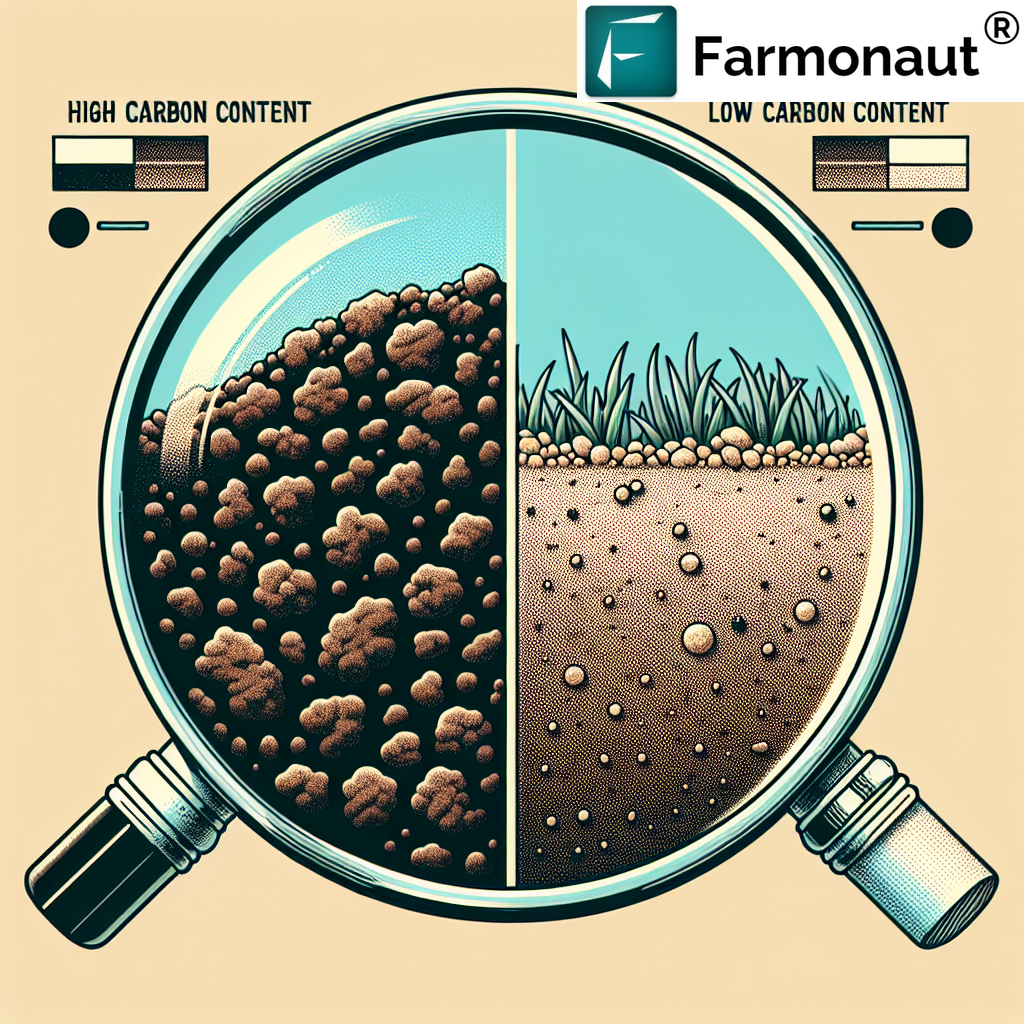
By understanding and managing soil carbon levels, we can not only improve agricultural productivity but also contribute to global efforts in mitigating climate change. At Farmonaut, we’re committed to providing the tools and knowledge needed to achieve these goals. Join us in revolutionizing agriculture for a sustainable future.
 In the ever-evolving world of agriculture, understanding the intricacies of soil health is paramount to achieving sustainable and productive farming practices. At Farmonaut, we’re committed to empowering farmers with cutting-edge technology and knowledge to optimize their agricultural endeavors. Today, we’re delving deep into a crucial aspect of soil health: carbon percentage and organic matter. This comprehensive guide will explore the significance of carbon in soil, methods to measure it, and how it impacts overall soil fertility and crop productivity.
In the ever-evolving world of agriculture, understanding the intricacies of soil health is paramount to achieving sustainable and productive farming practices. At Farmonaut, we’re committed to empowering farmers with cutting-edge technology and knowledge to optimize their agricultural endeavors. Today, we’re delving deep into a crucial aspect of soil health: carbon percentage and organic matter. This comprehensive guide will explore the significance of carbon in soil, methods to measure it, and how it impacts overall soil fertility and crop productivity.
 By understanding and managing soil carbon levels, we can not only improve agricultural productivity but also contribute to global efforts in mitigating climate change. At Farmonaut, we’re committed to providing the tools and knowledge needed to achieve these goals. Join us in revolutionizing agriculture for a sustainable future.
By understanding and managing soil carbon levels, we can not only improve agricultural productivity but also contribute to global efforts in mitigating climate change. At Farmonaut, we’re committed to providing the tools and knowledge needed to achieve these goals. Join us in revolutionizing agriculture for a sustainable future. 


